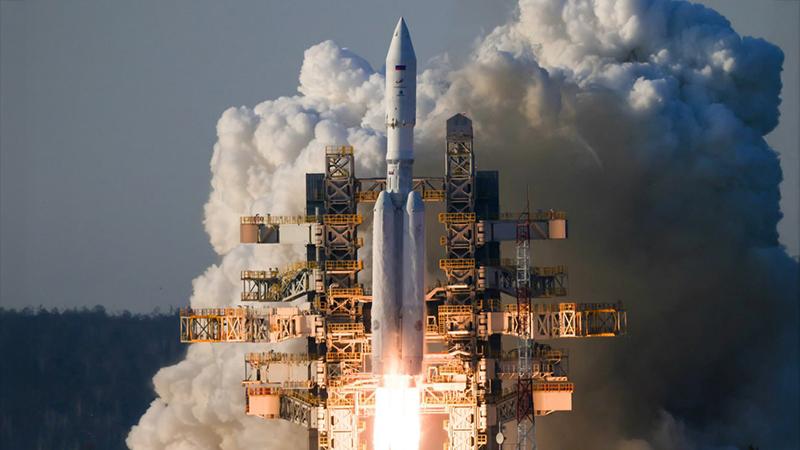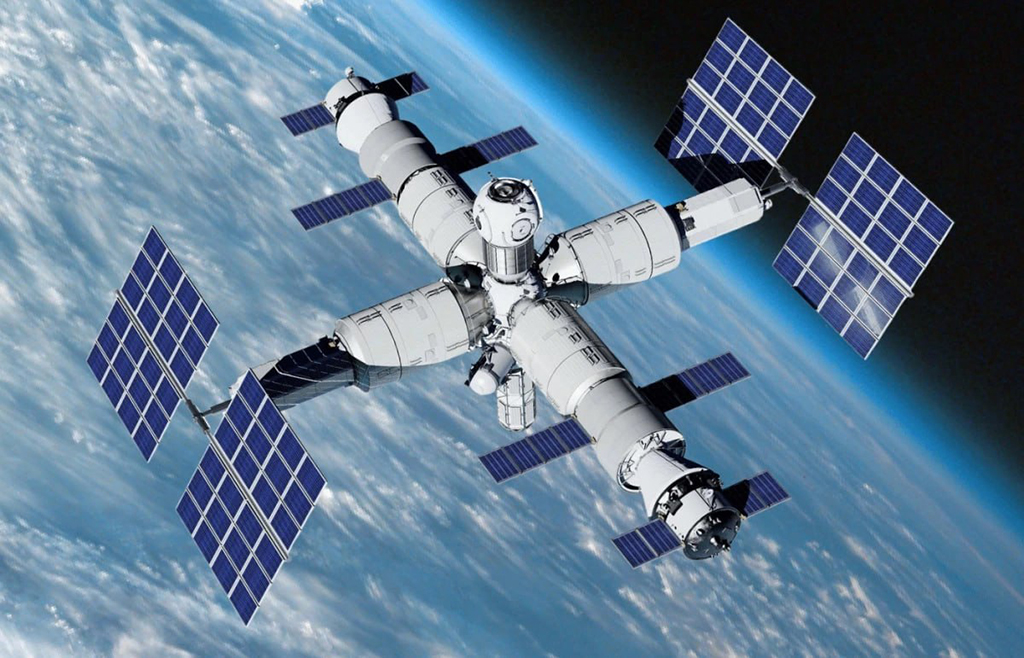This article is published in Aviation Week & Space Technology and is free to read until May 10, 2025. If you want to read more articles from this publication, please click the link to subscribe.
Western Sanctions Leave Russia’s Space Sector Out In The Cold

The Angara A5 flew for the first time from the Vostochny Cosmodrome a year ago.
Moscow’s space efforts face an uncertain future. A dearth of spending and years of Western sanctions in response to its invasion of Ukraine have undermined Russia’s position as one of the world’s preeminent space powers. Heavy investments by China and other nations have only added to the perception of Moscow’s decline.
Russia achieved only 17 space launches in 2024, ranking third after the U.S. and China. Almost 70 years after the Soviet Union launched the first artificial Earth satellite, Russia’s annual launch total reached its post-Soviet-era nadir in 2024, excluding 2020, when the COVID-19 pandemic began.
- Space workforce shrinks significantly
- Key space programs grapple with delays
“Since 2022, Russia’s space program has been in a state of turbulence and uncertainty,” Russian defense specialist Pavel Luzin said in a July 2024 report for the Foreign Policy Research Institute. In 2022, the country launched its full-scale invasion of Ukraine, prompting an escalation in Western sanctions and ending collaboration with Europe on Soyuz launches.
The problems run deeper, Luzin added, noting that they effectively began in 2014, when Moscow’s annexation of Crimea and attacks in Ukraine’s Donbas region spurred an initial wave of sanctions, including restrictions on deliveries of advanced industrial equipment. Those sanctions ruptured Russian ties with Western partners, except for operations on the International Space Station (ISS).
The war’s financial effects are compounding the Russian space sector’s problems. Moscow is prioritizing spending on its military and has allocated funding for space endeavors across multiple programs without providing critical mass to yield meaningful results. The industry is also struggling with high inflation and interest rates, Luzin noted, and the devaluation of the ruble is exacerbating its financial woes.
Russia’s space sector has also seen an exodus of experienced staff. In 2015-22, its workforce fell to about 170,500 from 235,700; 90% of those remaining are employed by the state-owned Roscosmos. That workforce suffers from low productivity and is spread across too many civil and military projects, Luzin added. Roscosmos suffered a cumulative net loss between 2015 and 2023 exceeding 110 billion rubles ($1.3 billion).
As a result, the launch industry is showing signs of strain. Russia’s first space launch this year also marked the final mission of the Soyuz 2.1v light launcher because the country effectively ran out of motors for the rocket type. The Soyuz 2.1v was derived from the workhorse Soyuz 2.1, excluding the four strap-on boosters but with the more powerful NK-33A core stage replacing the RD-108A engine. Russia inherited dozens of NK-33As from the Soviet lunar effort, which was aborted in 1974.
Roscosmos once planned to replace the Soyuz 2.1v’s NK-33A with the new RD-193 engine, which it had test-fired in 2013. By then, the space agency and the Russian military were already focused on the development of the new Angara 1.2 light vehicle. That launch vehicle first flew in 2014, replacing the Soyuz 2.1v for military missions from the Plesetsk Cosmodrome; another flight on March 16 lofted two military satellites.
The lack of clarity about Russia’s plans for a super-heavy launch vehicle for future lunar missions has raised questions regarding its role as an international partner—particularly for China, which is quickly developing its own launcher portfolio.
The main pillar of Moscow’s launch activities remains the leased Baikonur spaceport in Kazakhstan, used mainly to launch crew and cargo ISS missions. Roscosmos this year plans to conduct the first launch of the new Soyuz 5 medium-lift rocket to replace the Russian-Ukrainian Zenit 2. The two-stage Soyuz 5 is designed to deliver 17 tons of payload to low Earth orbit, about 50% more than the Zenit 2. The first stage is powered by an 800-ton-thrust RD-171MV engine, a modified version of the Zenit 2’s engine.
The commercial viability of the Soyuz 5 is unclear, however, since Western companies cannot use the rocket and Chinese launch vehicles are proving to be more competitive.
Russia’s own commercial spaceport, Vostochny, is mostly idle, given its lack of Western clients. Roscosmos first flew the Angara A5 from Vostochny a year ago. The site is the country’s only option for launching heavy spacecraft for the next 15-20 years, but none are scheduled there for the Angara until 2027. Roscosmos plans to modify the vehicle into the Angara A5M variant, with uprated RD-191 engines on the first and second stages to boost payload capacity 10% and support Russia’s ambition to deploy a new space station. In March, Roscosmos said it had completed development tests of the RD-191M engine to power the variant, paving the way to deliver flight engines for rocket testing.

Given its limited financial resources, Russia has prioritized military and dual-use satellites over other space investments, says Dmitry Payson, a senior research fellow at Dresden Technical University. Those efforts span the maintenance of the constellation for Glonass, Russia’s version of GPS, and development of new satellites for such applications as early warning, military communications, space surveillance, optical and radar imaging and civil communications.
Sanctions have hobbled those ambitions, too, particularly for communications satellites. “It is still unclear if Russia would be able to replace the suppliers with domestic and/or Chinese ones without a significant decrease in the constellations’ capabilities,” Payson says.
The country’s largest government-owned satellite communications operator, Russian Satellite Communications Co., announced the development of import-free satellites for its constellation, although the large-scale fleet renewal has been delayed until the end of the decade.
Also uncertain is whether Russia can maintain and refresh Glonass systems while foreign components remain out of reach. The country launched the first of the latest-generation Glonass-K2 satellites in 2023, but other spacecraft of this type are being modified to replace embargoed electronics.
Roscosmos announced the development of a new architecture for the system, requiring just six satellites in highly elliptical orbit instead of 18 in medium Earth orbit to provide coverage over Russia. However, they are not expected to be deployed until the 2030s.
Luzin said the Russian Armed Forces are dealing with Glonass issues by relying on consumer-grade GPS receivers or those that can use China’s BeiDou navigation satellite constellation.
These limitations are driving Russia to revamp its approach to satellites, he noted. Rather than pursuing high-end spacecraft, Moscow is prioritizing quantity over quality and moving toward simpler cubesats that can function with electronics that are easier to source amid trade restrictions. Although such satellites have shorter lifespans, Roscosmos is betting that it can produce them more easily and replace them in a timely manner.
Russia’s private space companies are already pursuing that design approach as they compete with Roscosmos for government contracts. Sitronics operates a ship-tracking constellation of 52 satellites that it plans to expand. The spacecraft are based on a cubesat developed by its subsidiary Sputnix, which built 120 cubesats in 2023 for its needs and those of other Russian customers.
Startup Bureau 1440 has received government backing to deploy low-Earth-orbit wideband satellite service similar to SpaceX’s Starlink. Bureau 1440 has launched two test missions and plans to orbit 292 satellites by the end of 2030.
While those efforts are breathing life into Russia’s space sector, they are also causing tension. Roscosmos last year complained that Bureau 1440 was poaching its personnel, Russian space analyst Vitaly Yegorov says.
Human spaceflight is another area where Russia’s future looks uncertain. The Soviet Union put the first human in space, and Russia has been a key partner in supplying and staffing the ISS, helping maintain Moscow’s status in space. But it is uncertain how the country will continue its human spaceflight program after the station is deorbited in 2030.
Roscosmos once considered exiting the ISS partnership early to free up financial resources to develop a new national orbital station dubbed the ROS. That ambition has come with sticker shock that has held back the effort. Russia’s annual cost of crewed space flights now is about 35 billion rubles, more than a quarter of the country’s entire space program, Luzin said. Creating a new station would cost even more.
Since the formal launch of the ROS program in 2021, Roscosmos has not secured sufficient government funding; the launch of the first element—the 20-ton Scientific Power Module, NEM—has slipped to 2028 from 2024. “The work on ROS is still on paper for now,” Yegorov said, pointing out that the new station will be much smaller than Russia’s section on the ISS.
Roscosmos’ deployment plan for the new orbital outpost has drawn criticism. The state-owned company plans to fly the ROS on a near-polar and sun-synchronous orbit to provide high-frequency observations of the entire Russian territory. Critics argue that satellites could do that more cheaply. The near-polar orbit also presents greater radiation exposure for cosmonauts, so Roscosmos wants the station to be occupied only periodically, further reducing its scientific value.
“Russia will continue to send its astronauts to orbit using Soyuz capsules, but the main purpose will be showing the flag without any tangible results,” Luzin stated.
Russia is also losing its role as a pivotal player in space cooperation. Since Moscow’s ties to the West are effectively frozen, and China is overtaking it in development of rockets and satellites, Russia’s partnership options have effectively shrunk to such countries as Belarus, Iran and potentially North Korea.


